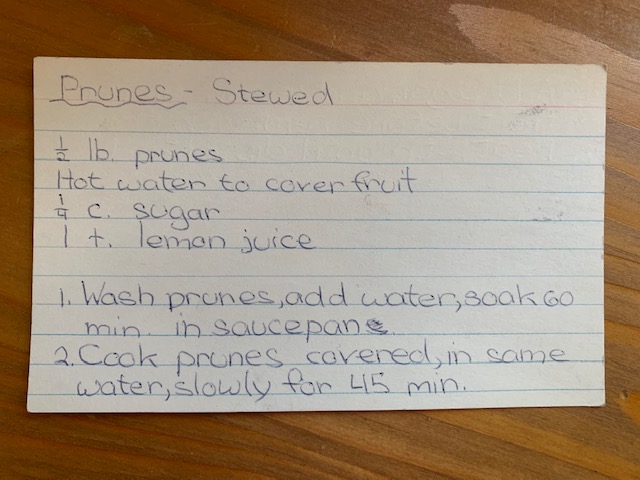I recently found this little beauty of a recipe card, historically a popular low-tech way of communicating how to make something to eat. In this case, it is my prized Stewed Prunes recipe. Even writing this makes me smile.
For a few reasons, it amuses me. Of course, I will share those reasons with you. We all need something light-hearted and of little consequence in today’s heavy times. Clearly, I’m either looking for pleasant distractions or I have too much time on my hands.

- This recipe card originated in my junior high home economics class, a required class at the time. Vintage 1967-68. I have saved it for sentimental reasons and it keeps me connected emotionally to a simpler time.
- Admire with me, if you will, the level of highbrow culinary skills reflected there.
- The seventh or eighth grade hand printing is rooted to my current printing, and is evidence of my quiet rebellion against cursive writing, the expected form of handwriting of those days, prior to keyboarding and digital recipes. Handwritten recipes are personally connected to the person who wrote it, and that is something sweet when we see the writing of loved ones.
- The power of the recipe card is in the endurance, lasting decades. We know technology and digital recipes are easy to store, move, and find. Until they aren’t. A handheld card, however, lasts and maintains its accessiblity no matter what problems you have with WiFi or technology.
- “Add sugar.” It is interesting to me to note how nutritional preferences have changed. I omit the sugar. My tastes have also changed. Culinary trends have changed.
- I’ve made these prunes often. My dad loved them and I must carry on the family tradition. Plus, I’m at that age where prunes serve a helpful purpose. Enough said.
I’m curious as to why the stewed prunes recipe was the recipe that day for a co-ed class of junior high students. When we made it, I’m sure it smelled up the classroom and possibly the halls while simmering away. But why stewed prunes? Did we really eat them after making them? And was it a two-day project or did the teacher soak them in advance? So much of this sweetly mystifies me. Perhaps someone creatively selected this recipe for its cost-effectiveness as well as a short supply list. Just curious.
Home Economics class and learning to cook in junior high. Did you have a cooking class in school? We took it for granted, but we were given life skills. Cooking together with a table of four kids, boys and girls, also required some skills to develop. Once our recipes were complete, we’d sit back down at the table, which each group had to set first, and we’d eat together. Conversation, evaluating the food and how we did, gave us social interaction that built friendships. When did we decide these courses would no longer be part of basic education in our public schools? Priorities shift. Prunes stay the same.
On the back of the recipe card, for those of you prune fans in my reading audience, the directions continue:
- Add sugar and lemon juice to the fruit before removing it from the heat.
- Stir until dissolved.
Prunes are beneficial to our health, too. For more on that topic:
7 Health Benefits of Plums and Prunes
I see how much value is represented in my simple yellowed Stewed Prunes recipe card, and that is why I’ve kept it all these years.
Stay charming, my friends.
